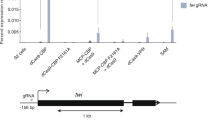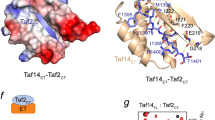Abstract
The MATα locus of the yeast Saccharomyces cerevisiae encodes two regulatory proteins, α1 and α2, which are responsible for determining the α-cell type1–4. MATα1 is a positive regulator of α-cell-type-specific genes, and MATα2 is a negative regulator of a-cell-type-specific genes. MATα2 also determines the a/α diploid cell type, in conjunction with the MATa product, a1, by repressing haploid cell-type-specific genes2. The MATα2-encoded protein binds specifically in vitro to a DNA sequence found upstream of several a-specific genes5 and is thus thought to exert its control directly at the transcriptional level of target genes. In an initial attempt to understand the molecular basis of the interaction of α2 with DNA, we have saturated with missense mutations the segment of α2 that is weakly homologous to a conserved prokaryote DNA-binding structure6–8 and to a portion of the higher eukaryote homoeo domain9,10 to ascertain the possible functional significance of this homology in α2. We report here that most of the amino-acid residues in α 2 which correspond to conserved amino acids in the prokaryote DNA-binding proteins and in the homoeo domain are essential for the two repressor activities of α 2, that is, the repression of a-specific genes and of haploid-specific genes. Mutations in a subset of these amino-acid residues more severely affect the ability to repress a-specific genes than haploid-specific genes.
This is a preview of subscription content, access via your institution
Access options
Subscribe to this journal
Receive 51 print issues and online access
$199.00 per year
only $3.90 per issue
Buy this article
- Purchase on Springer Link
- Instant access to full article PDF
Prices may be subject to local taxes which are calculated during checkout
Similar content being viewed by others
References
Mackay, V. L. & Manney, T. R. Genetics 76, 272–288 (1974).
Strathern, J. N., Hicks, J. B. & Herskowitz, I. J. molec. Biol. 147, 357–372 (1981).
Astell, C. et al. Cell 27, 15–23 (1981).
Tatchell, K., Nasmyth, K. A., Hall, B. D., Astell, C. & Smith, M. Cell 27, 25–35 (1981).
Johnson, A. D. & Herskowitz, I. Cell 42, 237–247 (1985).
Sauer, R. T., Doolittle, R. F., Lewis, M. & Pabo, C. O. Nature 298, 447–451 (1982).
Ohlendorf, D. H., Anderson, W. F. & Matthews, B. W. J. molec. Evol. 19, 109–114 (1983).
Laughon, A. & Scott, M. P. Nature 310, 25–31 (1984).
McGinnis, W., Garber, R. L., Wirz, J., Kuroiwa, A. & Gehring, W. J. Cell 37, 403–408 (1984).
Shepherd, J. C. W., McGinnis, W., Carrasco, A. E., De Robertis, E. M. & Gehring, W. J. Nature 310, 70–71 (1984).
Wilson, K. & Herskowitz, I. Molec. cell. Biol. 4, 2420–2427 (1984).
Jensen, R., Sprague, G. F. & Herskowitz, I. Proc. natn. Acad. Sci. U.S.A. 80, 3055–3059 (1983).
Pabo, C. O. & Sauer, R. T. A. Rev. Biochem. 53, 293–321 (1984).
Wharton, R. P., Brown, E. L. & Ptashne, M. Cell 38, 361–369 (1984).
Wharton, R. P. & Ptashne, M. Nature 316, 601–605 (1985).
Ebright, R. H., Cossart, P., Gicquel-Sanzey, B. & Beckwith, J. Nature 311, 232–235 (1984).
Weber, K., Platt, T., Ganem, D. & Miller, J. H. Proc. natn. Acad. Sci. U.S.A. 69, 3624–3628. (1972).
Matthews, B. W., Ohlendorf, D. H., Anderson, W. F. & Takeda, Y. Proc. natn. Acad. Sci. U.S.A. 79, 1428–1432 (1982).
Regulski, M. et al. Cell 43, 71–80 (1985).
Poole, S. J., Kauvar, L. M. Drees, B. Kornberg, T. Cell 40, 37–43 (1985).
Levine, M., Rubin, G. M. & Tjian, R. Cell 38, 667–673 (1984).
McGinnis, W. J., Hart, C. P., Gehring, W. J. & Ruddle, F. H. Cell 38, 675–680 (1984).
Colberg-Poley, A. M. et al. Cell 43, 39–45 (1985).
Joyner, A. L., Kornberg, F., Coleman, K. G., Cox, D. R. & Martin, G. R. Cell 43, 29–37 (1985).
Carrasco, A. E., McGinnis, W., Gehring, W. J. & DeRobertis, E. M. Cell 37, 409–414 (1984).
Nasmyth, K. A., Tatchell, K., Hall, B. D., Astell, C. & Smith, M. Nature 289, 244–250 (1981).
Hall, M. N., Hereford, L. & Herskowitz, I. Cell 36, 1057–1065 (1984).
Miller, A. M., MacKay, V. L. & Nasmyth, K. A. Nature 314, 598–603 (1985).
MacKay, V. L. & Manney, T. R. Genetics 76, 255–271 (1974).
Sprague, G. F., Rine, J. & Herskowitz, I. Nature 289, 250–252 (1981).
Wells, J. A., Vasser, M. & Powers, D.B. Gene 34, 315–323 (1985).
McNeil, J. B. & Smith, M. Molec. cell Biol. 5, 3545–3551 (1985).
Dente, L., Cesareni, G. & Cortese, R. Nucleic Acids Res. 11, 1645–1655 (1983).
Zoller, M. J. & Smith, M. Meth. Enzym. 100, 468–500 (1983).
Sanger, F., Nicklen, S. & Coulson, A. R. Proc. natn. Acad. Sci. U.S.A. 74, 5463–5467 (1977).
Maniatis, T., Fritsch, E. F. & Sambrook, J. Molecular Cloning: A Laboratory Manual (Cold Spring Harbor Laboratoy, New York(1982).
MacKay, V. L. Meth. Enzym. 101, 325–343 (1983).
Ebright, R. H. in Protein Structure, Function, and Design (ed. Oxender, D.) (Liss, New York, in the press).
Russell, D. W. et al. Molec. cell. Biol. (in the press).
Ruby, S. W., Szostak, J. W. & Murray, A. W. Meth. Enzym. 101, 253–269 (1983).
Rothstein, R. J., Esposito, R. E. & Esposito, M. S. Genetics 85, 35–54 (1977).
Author information
Authors and Affiliations
Rights and permissions
About this article
Cite this article
Porter, S., Smith, M. Homoeo-domain homology in yeast MATα2 is essential for repressor activity. Nature 320, 766–768 (1986). https://doi.org/10.1038/320766a0
Received:
Accepted:
Issue Date:
DOI: https://doi.org/10.1038/320766a0
Comments
By submitting a comment you agree to abide by our Terms and Community Guidelines. If you find something abusive or that does not comply with our terms or guidelines please flag it as inappropriate.



